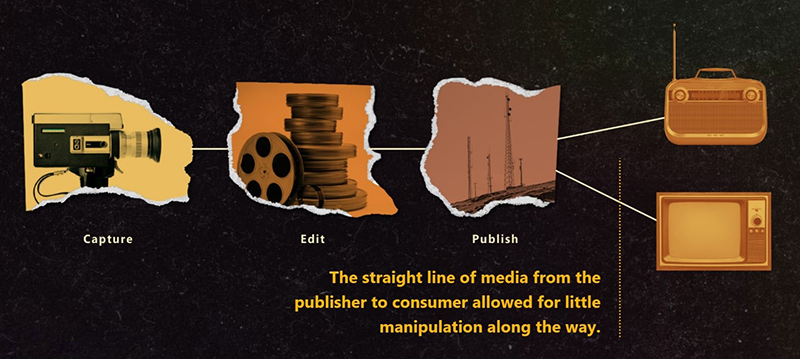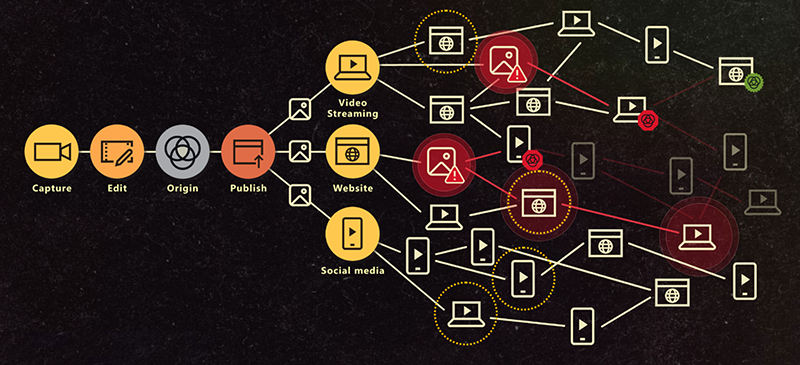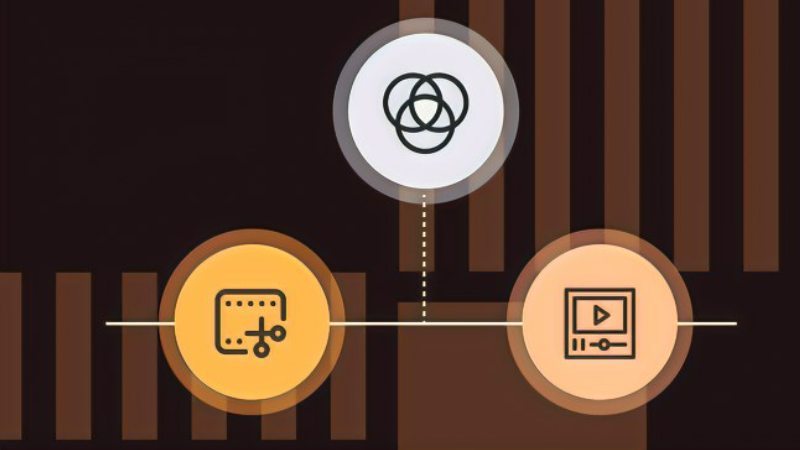Building trust at the Origin
Despite all the positives of synthetic media–create expression, educational applications, assistive technologies, entertainment–there’s a downside. It’s increasingly hard to detect, which leaves the door open for media to be altered after publication and spread as disinformation. Project Origin aims to create a measure of accountability through provenance. By certifying the source of the content like a watermark, we can safeguard against manipulation.
Scroll as we explore how media has evolved–and what the future will look like with Project Origin…

New challenges with new media
Media distribution has changed. Let’s explore how disinformation has seen trust in the 20th century media eroded in the 21st century–and what we’re doing to address it.
-
A straight line from producer to consumer
Traditional media used to be created by professionals, published or broadcast by institutional actors, and distributed to consumers, with little opportunity for manipulation in between. Because of those old closed systems for production and distribution, we could trust that what we saw and heard was what the media producer originally published.

The straight line of media from the publisher to consumer allowed for little manipulation along the way. -
Anything but a straight line
The internet and social media have created a vastly more decentralized distribution system for media. Content producers publish media on their own platforms, but media is often redistributed through third party publishers and millions of consumers on social media, before reaching our screens. When media gets altered in a misleading way, disinformation can spread like wildfire and erode trust.

Media is now published via a myriad of platforms. Once media is published, the redistribution and spread through user networks happens at an exponential rate. 
When media is manipulated after publication (read markings), it can spread without consumers being aware. 
As part of a publication process, new tools will register media items by creating a digital fingerprint. In return, the content creator will receive a certification of authentication, which will be stored in a tamper-proof distributed ledger with no single controlling entity. Now that certification can be embedded into a piece of media before distribution. 
Every time you consume a piece of media, the Web browser or dedicated application will automatically compare the embedded digital fingerprint of the file you’re viewing with the original stored in the distributed ledger. Based on that comparison, it will display a clear indicator (the red and green seals in the picture above), allowing you to understand if what you’re viewing has been tampered with. Producers: As part of the publication process, new tools will register media items by creating a digital fingerprint. In return, the content creator will receive a certification of authentication, which will be stored in a tamper-proof distributed ledger with no single controlling entity. Now that certification can be embedded into a piece of media before distribution.
Consumers: Every time you consume a piece of media, the Web browser or dedicated application will automatically compare the embedded digital fingerprint of the file you’re viewing with the original stored in the distributed ledger. Based on that comparison, it will display a clear indicator of authentication, allowing you to understand if what you’re viewing has been tampered with.
Partnering with content producers
For the ideas above to be effective, we need broad collaboration, from content producers, to distributors, cloud providers, and application developers. The first key step is having tools for producers to authenticate their content. That’s why we partnered with the BBC, the CBC / Radio Canada, and The New York Times, to expand the scope of Project Origin (opens in new tab). The project is also closely connected to the Trusted News initiative / Beyond Fake news from the BBC; see Project Origin: Securing Trust in Media – Beyond Fake News (opens in new tab).
Besides the news content producers, it is important that developers of software tools for media editing, especially at the professional level, to participate in these initiatives. That is why Project Origin is also closely connected to the Content Authenticity Initiative (opens in new tab), spearheaded by Adobe and with the support of many organizations.

The technical details on how to attribute and assert provenance to content to be distributed on the Internet are being developed by the Coalition for Content Provenance and Authenticity (C2PA (opens in new tab)). The founding members of C2PA include Adobe, Arm, BBC, Intel, Microsoft and Truepic. The initial C2PA specification has been recently published, and the group continues to work on expanding its capabilities. See more in this blog (opens in new tab) by Dr. Eric Horvitz.

Authenticity starts here
Project Origin has already taken a significant first step towards establishing a formal industry standard: the Coalition for Content Provenance and Authenticity, but there’s more to do.
The Coalition for Content Provenance and Authenticity (C2PA (opens in new tab)) will only work when it’s widely adopted.
Help us spread the word.

Learn more

Tech Minutes – Project Origin and AMP
Paul England covers Project Origin and AMP, a system that ensures the authentication of media via certifying provenance.

Project Origin technical deep dive
Discover the technical layers of Project Origin and AMP–Authentication of Media via Provenance.

Latest news about Project Origin
Learn more about new steps to combat disinformation.




